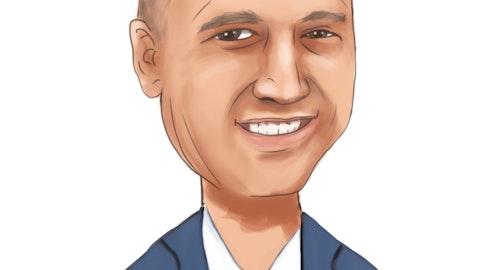Bank of Marin Bancorp (NASDAQ:BMRC) Q4 2023 Earnings Call Transcript January 29, 2024
Bank of Marin Bancorp misses on earnings expectations. Reported EPS is $0.04 EPS, expectations were $0.32. Bank of Marin Bancorp isn’t one of the 30 most popular stocks among hedge funds at the end of the third quarter (see the details here).
Operator: Good morning and thank you for joining Bank of Marin Bancorp Earning Call for the Fourth Quarter ended December 31, 2023. I’m Yahaira Garcia-Perea, Marketing and Corporate Communications Manager for Bank of Marin. During the presentation, all participants will be in a listen-only mode. After the call, we will conduct a question-and-answer session. Joining us on the call today are Tim Myers, President and CEO, and Tani Girton, Executive Vice President and Chief Financial Officer. Our earnings press release and supplementary presentation, which we issued this morning, can be found in the investor relations portion of our website at bankofmarin.com, where this call is also being webcast. Closed captioning is available during the live webcast, as well as on the webcast replay.
Before we get started, I want to note that we will be discussing some non-GAP financial measures. Please refer to the reconciliation table in our earnings press release for both GAAP and non-GAAP measures. Additionally, the discussion on this call is based on information we know as of Friday, January 26, 2024, and may contain forward-looking statements that involve risks and uncertainties. Actual results may differ materially from those set forth in such statements. For discussion of these risks and uncertainties, please review the forward-looking statements disclosure in our earnings press release, as well as our SEC filings. Following our prepared remarks, Tim, Tani, and our Chief Credit Officer, Misako Stewart, will be available to answer your questions.
And now, I’d like to turn the call over to Tim Myers.
Tim Myers: Thank you, Yahaira. Good morning, everyone, and welcome to our fourth quarter and full-year earnings call. I’d like to begin by providing a high-level overview of our financial results. During the fourth quarter, we took several actions to further bolster our balance sheet that contributed to improvement in our pre-tax, pre-provision income, excluding losses on security sales, in the quarter as well as laid the foundation for improved earnings growth in 2024. First we strategically repositioned our balance sheet by divesting lower yielding securities and further reducing our short-term borrowings. While the loss generated on the security sales lowered our earnings, we directed the proceeds toward new loan originations and repayment of borrowings to accelerate margin improvement in the coming quarters.
These actions countered the adverse impact of increased funding costs and supported our net interest margin expansion during the quarter. We believe that our current interest rate risk position will better support increased profitability in the year ahead as we navigate the potential higher for longer interest rate environment. Second, in keeping with our long established conservative approach to credit administration, we continue to proactively identify potentially vulnerable loans and during the fourth quarter, created specific reserves for select loans dealing with idiosyncratic issues that have exhibited extended periods of weakness. Specifically, we added to our provision for credit losses in the quarter, contributing to the increase in the allowance to 1.2% of total loans, compared to 1.16% for the prior quarter.
Overall, credit quality remains strong with non-accrual loans standing at just 0.39% of our total loans at quarter end. Additionally, classified loans declined during the quarter and comprised 1.56% of total loans and improvement from 1.9% at the end of Q3. We believe it is wise to conservatively address possible challenges early and proactively. This includes exiting relationships, evaluating loans with unique characteristics individually, or pursuing other credit enhancement opportunities on potentially problematic loans. We remain highly selective and committed to strong asset quality amid economic uncertainty and the likelihood that interest rates will remain elevated this year. During the quarter, our lending teams continue to build momentum, further developing relationships with our clients, and finding compelling new opportunities to grow originations as we cultivate and build a more diversified loan portfolio.
Our loan originations improved from $22.7 million in Q3 to $53.8 million in Q4 and were largely offset by payoffs, scheduled repayments, and strategic exits and certain lending relationships as part of our risk management process. Overall, this left total loans for the quarter essentially flat. Still, rates on loans we originated were 175 basis points higher than those paid off, helping provide margin support. We are positioning the overall portfolio for modest growth in the year ahead. Non-owner occupied commercial real estate loans made up 73% of total classified loans at year-end, up modestly from the prior quarter as we carefully monitor vacancy rates in the office sector. Our non-owner occupied office portfolio is diverse and consists of 153 loans with an average loan size of $2.4 million, the largest loan being $16.9 million.
The weighted average loan to value was 59% and the weighted average debt service coverage ratio was 1.6 times based on our most recent data. Our office CRE book in San Francisco represents just 3% of total loan portfolio and 6% of our total non-owner occupied CRE portfolio. Just to reiterate, we are continually looking for ways to enhance our collateral on potentially problematic credits, including working with our borrowers to secure additional collateral and/or revised credit terms, all with the view of minimizing the risk of future credit losses. Now turning to deposits. We continue to successfully attract new clients and deepen ties with existing customers to support our funding base. While deposits grew over the past two quarters, our deposits in Q4 declined moderately mostly due to activity from clients executing typical seasonal and year-end business transactions.
Since year-end, deposits have increased by as much as $104 million during January, which illustrates the impact normal large fluctuations can have on the daily balances due to our high level of operating accounts and why we maintain such high levels of liquidity. Additionally, we saw some customers move cash into alternative investments to capture higher returns, some of which were directed to our own wealth management group. Non-interest-bearing deposits at year-end remain strong at 44% of total deposits, and a majority of the non-interest-bearing outflows align with the same customer business activities we saw with overall deposits. Our average cost of deposits increased 21 basis points in the fourth quarter to only 1.15% continuing the deceleration of the last quarter.
We believe we are appropriately competitive on deposit pricing, while maintaining a strong core deposit franchise and excellent customer relationships through exceptional service and our local market expertise. As many of you know well, our overall cost of funds has historically trended well below pure averages, reflecting our long-term approach to customer engagement. We prove our value to customers with a robust suite of products and services rather than competing on price alone. Importantly, as we pursue improved profitability, we also remain highly focused on expense management. Our fourth quarter non-interest expenses declined 2% from the prior quarter. With respect to liquidity and capital, we continue to maintain high levels of both.

Security sales during the quarter reduced our capital sensitivity to rising interest rates. Our total risk-based capital ratio improved to 16.89% at year-end, compared to 16.56% at September 30. The 31% improvement in AOCI raised tangible common equity to 9.73% of tangible assets. Total available liquidity of approximately $2 billion at year-end consisted of cash, unencumbered securities and borrowing capacity. Importantly, our liquidity covers all of our uninsured deposits by over 210%. Uninsured deposits declined by a percentage point from the prior quarter and stood at 28% of our total deposits as of December 31. In summary, we made important progress on both sides of our balance sheet in the fourth quarter and throughout the second-half of 2023, aggressively taking strategic measures to drive profitability in the quarters ahead.
With that, I’ll turn the call over to Tani to discuss our financial results in greater detail.
Tani Girton: Thanks, Tim. Good morning, everyone. We’ve been working hard on many fronts to enhance and accelerate our profitability growth. Our tax equivalent net interest margin increase of 5 basis points in the fourth quarter followed a 3 basis point increase in the third quarter. Our balance sheet repositioning contributed 15 basis points reflected in reduced borrowings and securities and a lower average rate on borrowings and higher yields on securities. Loan yield improvements contributed another 10 basis points. Deposit cost increases reduced the margin by 20 basis points. We are optimistic that we will see further margin improvement in the coming quarters with a full effect of the balance sheet restructuring, our ongoing focus on selectively growing the loan portfolio, and the natural repricing of the existing loan book.
We generated net income of $610,000 in the fourth quarter, or $0.04 per diluted share, as compared to net income of $5.3 million, or $0.33 per share in the third quarter. There were two primary drivers of the fourth quarter decline in earnings. First, we recorded a $5.9 million pre-tax net loss on the sale of investment securities as part of our balance sheet restructuring, which reduced net income by $4.2 million, or $0.26 per share. Second, we had an $875,000 increase in the pre-tax provision for credit losses, due in part to specific allowances on loans that have exhibited credit risk characteristics not indicative of pooled loans under the CECL model. We have taken a proactive approach in recognizing these characteristics by removing the loans from the pooled loan categories and analyzing them individually.
Additionally, a $406,000 loss on the sale of an owner-occupied agricultural commercial real estate loan was charged to the allowance concurrent with the sale. Non-interest income, excluding the loss on the security sale, was stable for the quarter as modest increases from wealth management and trust services and other income were partially offset by a decrease in debit card interchange fees. Non-interest expenses were again well controlled in the quarter at $19.3 million, down from $19.7 million in the third quarter. The improvement was due to a combination of factors. Salaries and related benefits decreased $380,000, largely due to a decline in incentive-based compensation and partially offset by increases in regular salaries and accruals for insurance and employee paid time off.
Deposit network fees also decreased by $287,000 due to a decline in reciprocal deposit network balances. Decreases were partially offset by a $164,000 increase in professional services expenses. Putting it all together, our profitability ratios were significantly impacted by the loss on sale of securities in the fourth quarter, without which pre-tax, pre-provision income would have been 4% higher than in the third quarter. As everyone on this call is aware [Technical Difficulty] challenging year for the banking industry with several regional bank failures following the fastest increase in interest rates in 40-years. Bank of Marin was characteristically well positioned to weather the storm. We’ve always maintained strength in our capital and liquidity positions and exercise disciplined credit and interest rate risk management and conscientious expense control.
Since December 31, 2022, total risk-based capital improved 99 basis points to 16.9% for Bancorp and 89 basis points to 16.6% for the bank. Bancorp’s TCE ratio has improved 152 basis points over the year to 9.7%, and the bank’s TCE ratio has improved 143 basis points to 9.5% at year-end. If the net unrealized losses on held to maturity securities were treated the same as available for sale securities, Bancorp’s TCE ratio at December 31 would have been 7.8%. On balance sheet and contingent liquidity remain strong and represent 213% of uninsured deposits. Our deposit base is well diversified with businesses representing 59% of total deposit balances and 33% of total accounts, while the remainder are consumer accounts. The average balance per account on our deposit base decreased by $5,000 over the quarter.
Our largest depositor represented just 1.7% of total deposits, while our four largest depositors comprised 4.6%. Our interest rate risk position continues to be fairly neutral, although more liability sensitive than in past years due to the upward repricing of deposits. Security sales and reductions in borrowings added some asset sensitivity to the position. Cumulative deposit cost increases this interest rate cycle or the deposit beta have reached the levels assumed in our modeling and we are revisiting those assumptions in the context of our 2023 experience. Our Board of Directors declared a cash dividend of $0.25 per share on January 25, 2024, which represents the 75th consecutive quarterly dividend paid by Bancorp. While our share repurchase authorization remains in place, we didn’t repurchase any stock during the quarter as we were focused on continuing to build our strong capital, increasing our allowance for credit losses and repositioning the balance sheet for the new interest rate environment.
We have identified and implemented incremental adjustments across our balance sheet and expense structure to accelerate net interest income expansion and to self-fund efficiency improvements. And we will continue to look for further opportunities. Our vigilant credit administration, consistent expense discipline, and commitment to strong capital and liquidity levels give us a strong foundation to continue pursuing prudent growth in the year ahead. With that I’ll turn it back to Tim to share some final comments.
Tim Myers: Thank you, Tani. In closing, the actions taken in the fourth quarter significantly impacted profitability metrics in the fourth quarter and without them the pre-tax, pre-provision income would have increased over that of the third quarter. We continue to emphasize our relationship-based banking model to maintain an attractive deposit mix and healthy liquidity levels, while proactively managing our balance sheet to expand our net interest margin. We remain committed to recruiting top talent and further building our teams to grow both deposits and loans, positioning the bank for increased profitability into the future. We continue to fortify our balance sheet and maintain robust capital levels to manage risk and are exercising consistent expense discipline as we lay the foundation for prudent growth in 2024. With that I want to thank everyone on today’s call for your interest and your support. We will now open the call to your questions.
See also 15 Best Annual Dividend Stocks To Buy Now and 15 High Quality Dry Cat Food Brands in the US.
Q&A Session
Follow Bank Of Marin Bancorp (NASDAQ:BMRC)
Follow Bank Of Marin Bancorp (NASDAQ:BMRC)
Operator: [Technical Difficulty] the floor for questions. [Operator Instructions] Our first question will come from the line of David Feaster with Raymond James. Your line is now open. Please go ahead.
David Feaster: Hey, good morning, everybody.
Tim Myers: Good morning, David.
Tani Girton: Good morning.
David Feaster: Perhaps not surprisingly, I was hoping to start on the margin. Can we talk a bit about how you think about, I guess, first of all, what do you think would be a good core margin run rate? I mean, there’s been a lot of balance sheet maneuvers that you guys are doing. You’ve been very active. So curious about how you think about a good core margin? And then just the trajectory in a potentially declining rate scenario. You screen as modestly liability sensitive. You alluded in the press release maybe a bit more rate neutral. So just curious, anything about the margin trajectory if we do get potential cuts?
Tim Myers: Yes, thank you, David. Good question. I’ll let Tani jump in here.
Tani Girton: Yes, thanks, David. So we still have some residual loan repricing coming off the book to the current levels of interest rates. So, you know, in the go-forward quarter or the first quarter, that’s worth about 7 basis points end-to-end or 14 end-to-end 7 on average. And over the year, about 46 basis points end-to-end or about 23 basis points on average. And that is roughly, you know, that’s in the base case with interest rates flat. So, you know, if you have rates going up, it’s more than that, but you also then have offsets of deposit rates going up possibly. And we are revisiting our deposit data assumptions there. But if you, you know, if we go down, we still have some residual repricing on the loan portfolio, plus we would have repricing on the deposits.
So it’s really difficult to say what the deposits are going to do on the repricing, although we do feel that that’s going to continue to moderate in terms of increases if the Fed stays on pause. And then, you know, the last factor there, as I mentioned, was the residual or the full effect of the securities or the balance sheet restructuring. So we have zero borrowings on the balance sheet right now. And so I think that, you know, there’s some, the full effect for one quarter versus we executed those transactions over the course of the fourth quarter. So we didn’t get the full impact in the fourth quarter.
David Feaster: Sure. Do you have maybe kind of any expectation for what inclusive the margin would be inclusive of all the balance sheet actions?
Tani Girton: You know, I think in the next quarter, you know, 5 to 10 basis points. And for the core margin, boy, that’s a really tough question. That’s a hard one to say just, because there’s so many moving parts.
David Feaster: Yes. And to your point on the deposit side, maybe switching gears there, appreciate all the commentary about seasonality and the potential benefits in January. I know there’s some seasonal tax impacts in the quarter as well. Could you maybe just dig into and maybe quantify some of the seasonal dynamics that you saw in the quarter? And whether you started to see those balances recover in January like you had mentioned. And just how do you think about your ability to reprice deposits, just given deposit betas are relatively slow on the way up? And just any thoughts on the deposit outlook and kind of what you’re seeing?
Tim Myers: Sure. So about 80% — 79, 80% of the deposit outflow overall in the quarter was related to some combination of seasonal or what I would call unique but normal business transactions, business sales, trust distributions, business or real estate acquisitions. So not vendor payments or tax payments like you alluded to, but normal business activity. That was the vast majority of it. And we’ve had inflows in those same kind of accounts upwards of over $100 million throughout the month of January. So, you know, we know that that’s a real factor. We did have about $25 million leave to go to outside brokerage rate, but that’s down dramatically from Q4 when we admittedly got flat-footed trying to be stubborn about deposit pricing before the events of March, that was over $70 million in that category at the time.
So, but those aren’t customers we’ve lost. If you look at the dollars of deposit decline from lost business, it’s less than 1%. So we’ve really done a good job of repricing the amount we brought in through our deposit campaign, we talked about the last couple quarters, almost $130 million, that weighted average is about 3.36 all in. So to your point, we’re trying to hold the line on a relationship-based pricing model, still almost everything exception-based pricing, and we’ve already been strategizing about, okay, what do we do when rates start to come down and how do we respond? So a pretty minimal amount in time deposits, all of which mature in this year. But that was a fairly, I think, $18 million. So really trying to keep it in a few types of accounts that we can manage as proactively as possible.
But that’s kind of the math around. In deposits overall, we had about $25 million also moved from non-interest bearing into interest bearing. But those are clients that are again, still within the bank. So we don’t, you know, that’s — and we had about $5 million net of money that went from deposit accounts here into our wealth management trust group to put into higher yielding securities. So that’s the general breakdown, David.
David Feaster: Okay. That’s extremely helpful. Thank you. And then maybe just last one for me, just touching on the growth outlook in the loan, some of the dynamics in the loan decline. It seems like maybe there was more asset sales and payoffs in the fourth quarter. Maybe there’s some strategically that you’re moving out of the bank, but I’m just curious maybe the pulse of the market from your standpoint, now demand’s trending? How the pipeline’s shaping up? And just how you think about organic well growth going forward?
Tim Myers: Sure. So we had a lot of robust activity, pipeline and closing in Q4. The mix is slightly more skewed towards C&I and owner users than maybe some of the prior quarters, but kind of overall mirrors the makeup of the overall portfolio on the originations. Obviously, when you close that much, you’ve got to rebuild the pipeline, but we feel better about where it is than we did a couple quarters ago for sure. And so we are aggressively looking, we’ve added some hires on the commercial banking side, looking to add some more, but part of that behavioral, part of that market sentiment, we are seeing a loosening of people willing to consider some of these options, you know, business transactions for which they need to borrow.





